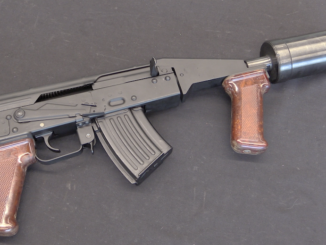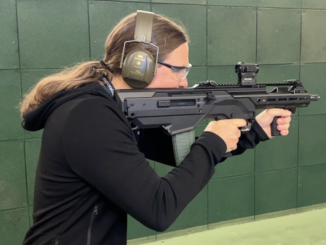The Blyskawica (“LIghtning”) is an SMG developed in occupied Poland to be issued out to Home Army units during Operation Tempest; the liberation uprisings planned for the advance of the Red Army into Poland.
The gun was developed starting in September 1942 by two engineers, Wacław Zawrotny and Seweryn Wielanier. Both were smart and talented, but neither had previous experience in arms design. The design they created is both innovative in some areas and inferior in others as a result, with major inspiration coming form the Sten and the MP40. Production was undertaken in the harshest conditions of occupied Warsaw, where just possession of cutting tools required German military permission.* It is a credit to the skill and dedication of the Home Army team that some 750 Błyskawica guns were made; the largest mass production of any underground weapon that I am aware of.
Ultimately, Operation Tempest did not come to full fruition, as the NKVD’s treatment of Polish fighters as collaborators destroyed Home Army interest in cooperation. The Błyskawica guns were never issued in mass as planned, with only the few dozen last made being used in the Warsaw Uprising. The remaining 700-odd examples have never been found – perhaps they remain in long-forgotten caches still to this day?
For the full story of the Błyskawica, see Leszek Erenfeicht’s excellent article:
Many thanks to the Polish Army Museum for giving me access to film this exceptionally rare item for you! Check them out at: http://www.muzeumwp.pl/?language=EN
* This created some interesting situations in which a shop might take a contract to make material for the Wehrmacht as a way to get access to the tools needed for Błyskawica component production. To those who did not know the whole story, such a shop was collaborationist.




russia was and still is a truly horrible country
Its biggest victims are their citizens.
But, stockholm syndrome wise, some enjoy their unhappy status! Thats why its impossible to change that behemoth
Speaking as someone who is of partial Polish descent, Russia and Russians suck. “Poland has not yet perished,
So long as we still live.
What the foreign force has taken from us,
We shall with sabre retrieve.”
Then you might interesting https://www.youtube.com/watch?v=WGlARPI6OtE as it show fragment of production process of Błyskawica machine gun.
On the end of video they show some casting of something, is that related to gun ?
There exist one example which is still functional, see https://www.youtube.com/watch?v=uNx41U3nfSk
So many questions.
Did the Home Army have any ammunition making facilities?
Under last-ditch conditions, how much aluminum was really available?
The sheet-metal folding stock looks like an improvement over all the rod-metal versions. Even with the short pull, was the stock more stable than the MP40’s/M3’s etc.?
Yes they did, from assembling luger ammo(history similar to „lunchbox” VIS pistols), through making grenades(not only of hand variety, but for launchers as well), to small chemical plants(for example things like „nitrating kerosene” or making cheddite like explosives).
BTW – copies of Sten(usually Mk II) were manufactured at much larger(3x to 5x) scale than Błyskawica.
The Grenzschutzschule at Lübeck (now Bundespolizeiakademie of the German federal police) in the 1970s also had a specimen in its collection. Condition was excellent.
At the time I had absolutely no knowledge that this was a gun made clandestinely in Poland under German occupation.
Many thanks, Ian!
Czapką do ziemi.
That safety is kinda like the idea of the Glock trigger safety just backwards – internals aside.
Ian danced around the lightning bolt logo a bit. Sure, electric ovens and all but still unmistakable as the “three arrows” of the Iron Front.
IIRC there is only one known examle of this SMG with three arrows.
In his prototype, Wielanier cut two simple(without spear/arrowheads) broken lines*, same goes for serial made ones(although they were more likely cast at this stage).
*and by simple I mean something just sligtly complicated than some versions of greek letter qoppa(Kkoppa), old italic(etruscan) s, hebrew lamedh or – if You wish – eleventh of the so called „armanen runes”.
I just hope the blueprints are still kept somewhere, in Warsaw, or in Beskidy Mountains hut…
(may be needed, soon)